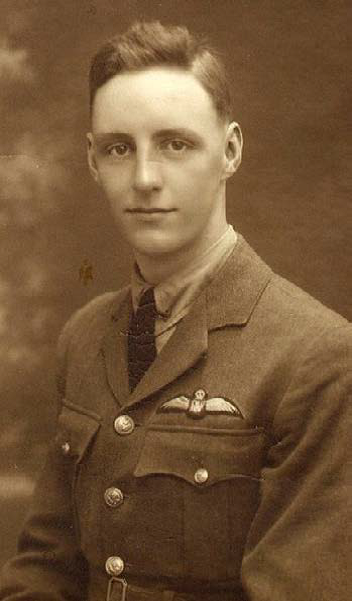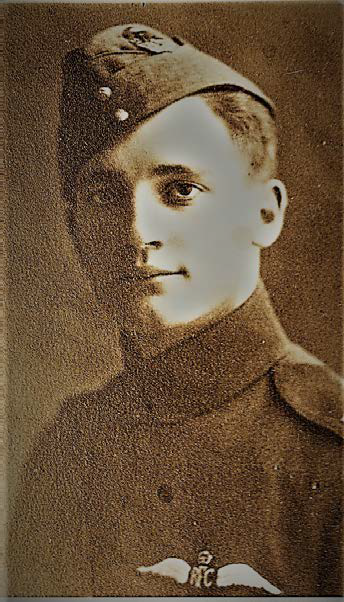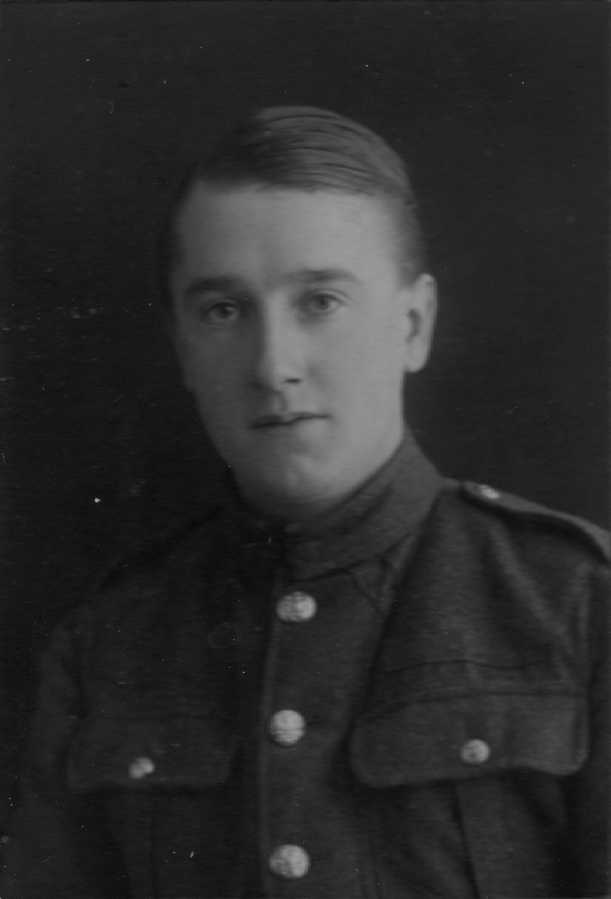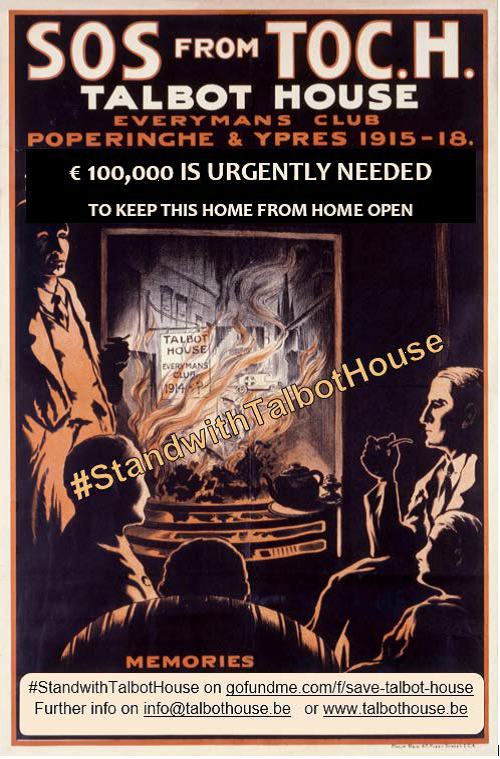Chairman’s Comment
I start by reporting, with sadness, the passing of two people well known to us all.
Our loyal and long-standing member Alex Hamilton has passed. Alex had only just settled into a care home, having been unwell for some time. She was found collapsed on the floor, and did not suffer at all. There will be a memorial service in the future.
Jon Cooksey, editor of “Stand To!” passed away suddenly last Sunday morning. A tribute will appear in the next Bulletin. Jon was booked to speak at our October meeting which would have been his first visit to the Armoury.
Further to the Appeal in the last edition of UTL you will be pleased to hear that our Branch has donated 150 euros to Talbot House, Poperinghe. I’m told the national WFA and other branches have together donated nearly £3,000 to their cause.
In regards to the article inside on the two young Canadian airmen who died in June 1918 and are buried side-by-side in Siddington churchyard. This Friday 19th is the anniversary of their burial and Eric Hunter and I will lay some flowers on behalf of our Branch. I’ve been in contact with the Chairman of the Ontario Branch of the WFA, Glenn Kerr, who wants to feature the story in their ‘Maple Leaf’ magazine. He is trying to trace relatives to inform them of their ancestor’s remembrance. Glenn will send me a pdf of the mag and I’ll distribute to members.
The month has flown by again and as I write we have passed the 76th anniversary of the D-Day landings. This was accompanied by much interesting television documentary. Somebody seems to find something new, a different angle, to explore, investigate and recreate this cataclysmic event. The research to find wreckage on the seabed and the amazing removal of the sea to show the remains of ships and tanks etc is fantastic. The highlight is the computer recreation of the Mulberry Harbour at Arromanche, both above and below sea level giving a ground breaking analysis of this engineering masterpiece.
We are now three months or more into the CV19 pandemic and there is a slight relaxing of the situation. Let’s hope the general public don’t get too carried away. I’m sure the older generation will continue with caution and mainly stay at home but there is some coming together with family and friends. We’re now thoroughly aware of the danger of passing the virus so most people have adopted the advice given.
We can only hope that things will have changed for the better by end July but we currently have no way of knowing. John Derry was booked for August but sadly this has also been cancelled. For September its wait and see but I don’t hold out any hopes and I await advice from the Armoury of a re-opening date? If and when we might find ourselves meeting in the Drill Hall.
Various other branches are sending talks etc and I will continue to feed these on to our northwest readership. We’ve had a talk by Taff Gillingham on ‘Hats and Helmets in the Great War’ and this week Mark ‘Foz’ Fosdyke speaking on the ‘1st Suffolks: Dunkirk, Normandy and on to VE Day’.
I again recommend you keep looking at the WFA website www.westernfrontassociation. com as well as our own website www.landcwfa. org and I can particularly recommend the WFA YouTube section for video presentations by numerous historians speaking at WFA events and the Podcasts of which 140+ have been produced and made available by Dr Tom Thorpe, WFA Trustee.
Ralph Lomas
WWI Canadian Airmen buried at Siddington, Cheshire
Eric Hunter
Invariably, young men, fast machines and taking risks are a tragic combination. On Sunday 16th June 1918 two Canadian flyers were involved in a fatal aircraft crash at Thorneycroft Hall, Siddington, near Macclesfield, Cheshire.
They had flown their RE8 aircraft (reg. Number D4985) from RAF Shawbury, near Market Drayton, Shropshire, ostensibly a training flight but more than likely to pay a courtesy visit to the owners of the hall. They both served with 131 Squadron which was formed at Shawbury on 1 March 1918 as a training squadron. It was planned that it should become a DH9 day bomber unit and to this end it was to have moved to Kenley on 26 August, but on 17 August 1918 it was disbanded.

The pilot 2nd Lt Alexander “Buller” McGillivray, RAF, aged 18, from Hamilton, Ontario, had previously been forced to make an emergency landing in the hall’s grounds and remained as a guest of the Bickerton family while his aircraft was repaired. He was only 17 years old when he enlisted and went to the USA to do his pilot training. Following the successful completion of his training he was commissioned to the RAF in April 1918. As a dashing young RAF officer he became a hit with the young ladies of the hall and they encouraged him to return to see them before he departed to France. (Photo left)
The other occupant of the aircraft was 21 years old, 2nd Lt Claude Watchorn. RAF. He occupied the rear observer seat but was a qualified pilot in his own right. The son of George E. and Juliana Watchorn he was born at Merrickville, Ontario, the family subsequently moved to Calgary, Alberta. He was commissioned also in April 1918 having previously been at Queens University Calgary. While at university he enrolled in the Queens Battery (OTC) prior to that he was a member of the Calgary Flying Corps, travelling to Bisley, England in 1913 to represent them ina shooting competition. Both pilots did their initial flight training in Texas. (Photo left below)
On the fateful day Lt. McGillivray booked the aircraft out and Watchorn who was off duty accompanied him for the 44 mile flight. The RE 8 was supposedly an improved version of the BE2 bomber, but it was an unforgiving craft and caused many accidents to pilots in training. One of its characteristics was, after landing into wind, that the aircraft’s nose would always veer into the wind direction when taxying which made it difficult to handle on the ground.
The owners of the hall had presumably erected a makeshift flag pole to act as a rudimentary wind sock to aid the pilot. Unfortunately, according to the eye witness accounts the plane’s wing clipped one of the retaining ropes to the flag post and severed part of the wing. With no hope of landing safely the craft ploughed into the ground. The pilot was killed at the site but Lt Watchorn survived the crash and was taken to the local hospital in Macclesfield but died the following day Monday 17th June. An inquest was quickly convened allowing them to receive a full military funeral the following Wednesday 19th June. Colleagues from the RAF formed a guard of honour. They were laid to rest side by side in a plot, adjoining the south path, usually allocated to the local gentry, at All Saints, Siddington, the church McGillivray had attended only the week before as a guest of the Bickerton’s. Interestingly, for reasons not clear Lt. Watchorn gravestone commemorates him as being in the RFC as opposed to the RAF. The Reverend Canon Elstob performed the service. Two oak trees were subsequently planted at the crash site which remain there to this day.
A small part of Cheshire will be forever Canadian.
Eric Hunter
Eds note: Thanks to various sources as to the events surrounding the crash on 16th June, 1918 and the prompt internment of the two airmen at Siddington Church on the 19th June. Flowers will be laid for this 19th June anniversary by the Lancashire and Cheshire Branch of the WFA in remembrance of these two young men who, far from home, sadly died before being able to play any part in the Great War.
Sources Information in the church porch provided by local historian Raymond Rush
h t t p : / / w w w. m i l i t a r i a n . c o m / t h re a d s / c a n a d i a n - f l y e r s - f l y i n g - a c c i d e n t - a t - thornycroft-hall.7010/
h t t p s : / / w w w . v e t e r a n s . g c . c a / e n g / r e m e m b r a n c e / m e m o r i a l s / c a n a d i a n - v i r t u a l - w a r - m e m o r i a l / detail/80001251?Alexander%20George%20 McGillivray
inline_content_modal_1 https://www.thornber.net/cheshire/htmlfiles/ siddington.html
A Soldiers’ Story
Sam Sutcliffe: Arras to 11th November 1918 and post-war
experience to 11th November 1919 with demob
Phil Sutcliffe
Signaller Sam Sutcliffe, my father, wrote his WW1 Memoir, Nobody of any Importance, in his 70s from a near perfect-recall memory – as I know from editing and footnoting the lot, starting from his reel-to-real tape and Typescript and handwritten original. Born rich in Salford, 1898, through family misfortune he grew up poor in north London. He lied about his age to join up in October, ‘14, then fought at Gallipoli (Suvla Bay, V Beach) and the Somme (Gommecourt). Then, his age discovered – still too young for battle – he returned to England. After a year’s “training” and being ill quite a lot, in December, 1917, aged 19, he had to prepare for his next little trip abroad… and here’s a taster of the talk/reading scheduled for next January.
“Everybody knew the Germans were making obvious preparations for one final massive attack,” Sam wrote. He got a few days leave at home. His parents and their five children – including Sam and older brother Ted also in the Army – had just moved house so he busied himself with shifting furniture and laying lino (“My top contribution. It did sterling service for many years after the war”).
But he wanted to talk and eventually got their collective attention: “I told the family that, in the New Year, our men would have to hold back or delay the masses of Germans who would follow up the concentrated artillery bombardments of our positions; that I should be just one little man among all the mess and muddle, but that, for some reason I could not explain, I felt certain I would survive, even though, for a while, I might not be able to keep in touch with the family… I had no notion of what this optimism was based on.”
Strange confidence indeed, from a lad who’d fought in the front line at Suvla Bay and the Somme. By then in his third Battalion – 2/7 Essex Regiment – he sailed solo to France, spending a week or so at a huge Army camp in Calais before despatch to Arras where “consciousness of a distant rumble, a continuous underlying vibration… by night, brilliant flashes… reminded me that peace and relaxation had once again passed from my life”.
Billeted in the city’s ruined prison, he quickly befriended a Battalion-mate and fellow Signaller he aliased as Neston. At Brigade HQ’s behest they “freelanced” around the nearby trench lines until, on March 11 or 12, they ran into the 2/7th – billeted briefly in a bomb-damaged museum (Des Beaux Arts I think). A week later they moved up to Fampoux, 8 kilometres due east. On March 23, with the Spring Offensive under way around St Quentin and shelling begun in their sector, the 2/1 Essex relieved entered the front line, Sam and Neston joining Signaller colleagues, and what he soon realised was a “windy” C Company CO, in the security of a dugout… if only they hadn’t been compelled to step outside once on a while…
“I went ‘up top’ only when my turn came to follow a line till I found the broken cable which had cut off communications. Life became terribly hectic then; a real screamer would send me down flat on my belly.
“Occasionally, a section of trench was blown in; there I must join spare cable to the near end of the broken line, carry it over the hump and connect my spare to the other end — all done in a rather exposed situation, usually with nobody in sight, no one to witness my skilled workmanship and brave devotion to duty… or maybe my cringing, crawling and fumbling, take your choice.”
Then came the pre-onslaught artillery bombardment: “All around us, shells of every calibre were bursting and busting up the landscape… The initial shock, caused by the realisation that ‘This is it’ as much as by the actual noise and destruction going on around me, soon settled into the state of high tension so familiar to me from earlier bombardments…”
It was Sam who, on the stroke of midnight, March 28, took the Regimental HQ message consigning Company and Battalion to… whatever befell each man from obeying the order to “stand firm and under no circumstances leave your present position”.
They didn’t. Reckoning their signalling work done, Sam and Neston joined their comrades on the firing step: “The first glimmer of dawn lightened the day. We checked our rifles, the bullets in our pouches. Up on the firing-step we could find no targets so far…”
The Company CO remained in the dugout in a funk, one Lieutenant shot himself, another had half his face blown away and reeled about on top until lost from view.
“Shells of all calibres burst around us. I now felt sort of mentally stunned and a looker-on, as it were, at the heaving destruction, wounding and killing on both sides of me for as far as I could see. Still no targets for my bullets, no outlets for my pent-up fears… if this continued for much longer I guessed I’d explode from within, regardless of enemy shells.
“When, suddenly, the artillery barrage lifted from our area, the relief we felt was quickly replaced by amazement at the sight of rows of huge, grey-clad men methodically taking over No Man’s Land.
“Without waiting for orders — orders from whom, anyway? — we commenced firing. Thereafter, we paused only to reload our rifles and, in the mist, our human targets appeared huge and unmissable.
“Germans fell, each possibly victims of more than one British marksman. Since they still came onwards, steadily, we just fired, fired, reloaded and fired again…”
Like target practice. Except that amid the carnage my father, shooting like an automaton, started thinking… that he was killing people. It stayed with him for the rest of his life.
“At one point Neston yelled, ‘Duck! Jerry half-right!’ and in a split second I’d seen this tall German coolly standing a few yards away with his rifle trained on me, so down! quickly and phutt, the bullet just missed my helmet. A cautious peep revealed the tall Jerry, confident and careless man, sprawled on the ground facedown.”
Eventually, Sam emptied his ammunition bandolier. The Battalion fired its last shot, lobbed its last grenade. Men milled about. Some honourably scarpered. Neston did, but only after he and Sam released their carrier pigeons carrying a message to Division HQ reading: “No ammunition left. Almost surrounded by the enemy. Good-bye.”
Sam, for no rational reason, just shattered, stood out on top facing the onrushing “Jerries”, waiting to be bayonetted… only to be spared… because young German soldiers didn’t want to bayonet anyone either?
So he became a prisoner of war. No purpose-built POW camp for him and his fellows, but eight months of wandering in occupied France and, latterly, southern Germany, then Lorraine – Sancourt, Marchiennes, Hügelheim, Mühlhausen… Hard-labouring months of malnutrition, dysentery, filth, lice, grinding fatigue and intermittent brutality from their Landsturm guards – mitigated by the kind fellow feeling of German front-line soldiers they encountered passing by.
Until November 11th. Sam had spent the last few weeks in an improvised “camp” in a Lorraine village. And that day German troops came racing by, eastwards, many shouting out the lovely word, “Armistice!”
Soon the POWs began their long walk west towards the French lines. Physically weaker than most from his long captivity, Sam fell behind: “Tottering onwards, resting, losing track of time… I felt like the last man left on earth.” En route the skill and knowledge of two British nurses, oddly alone in “occupied” territory, probably saved his life – one reason all proceeds from my father’s Memoir go to the British Red Cross.
At last, after four days on the road, he inched through a German minefield in No Man’s Land to reach a French trench whence, over some weeks, assorted French, British and American hospitals restored him – and one over-enthusiastic American officer nearly killed him with a massive meal his damaged guts just couldn’t take.
On December 10 he left a hospital in Rouen and travelled back to London… and the family reunions he longed for, with his father – ”He had never been demonstrative, but his greeting on that occasion was the warmest ever and added to my seething, happy excitement” – and his mother – “She greeted me warmly, without restraint, and I wasn’t reticent either… Over that first, lovely, Ma-made cuppa, we discussed everything as it came to mind”.
© Phil Sutcliffe
Of course, many another story lies between the lines of the above – and you can hear some of them at Stockport WFA next January. In the meanwhile, if you’d care to read Sam’s writings in print or e-book – all proceeds to the Red Cross (£5,000+ raised so far) – see:
Nobody Of Any Importance: A Foot Soldier's Memoir Of World War 1 by Sam Sutcliffe, edited by Phil Sutcliffe, paperback or e-book, direct from

Edward Brittain
Edward Harold Brittain (MC), Captain, 11th Bn Sherwood Foresters (Notts & Derby Regt) Died 15th June 1918 in Italy, aged 22. He was the brother of Vera Brittain, who served as a Red Cross VAD in London, Malta and Étaples, France and was the author of Testament of Youth.
Early Life
Edward Brittain was born on 30 November and baptised on 27 December 1895 at St Michael’s Church, Macclesfield, the son of Edith Mary and Thomas Arthur Brittain, a paper manufacturer of “Glen Bank”, Chester Road, Macclesfield. The family later moved to “Melrose”, Park Road, Buxton, returned in 1916 to live at “Sunny Bank”, Upton, Macclesfield, and subsequently moved to 10 Oakwood Court, Kensington, London.
Military Service
On 8 July 1916 the Macclesfield Courier reported that Edward Brittain had been wounded: LIEUT E H BRITTAIN – Mr T A Brittain, of Sunnybank, Upton, has received intimation this week that his only son, Lieutenant Edward Harold Brittain, of the Sherwood Foresters, was wounded at the battle of the Somme on Saturday, and is now in hospital in France. Our readers will probably remember that for many years, up to ten years ago, Mr and Mrs Brittain resided at Glenbank, Chester Road, where their son, Lieutenant Brittain, was born. Some ten years ago they went to reside in Derbyshire, and recently returned to Macclesfield. Lieutenant Brittain received his commission in November, 1915, and he has been on active service since February last.
The death of Captain Brittain was reported in the Derbyshire Advertiser and Journal on 28 June 1918:
A SHERWOOD OFFICER: Captain Edward Harold Brittain, M.C., Sherwood Foresters, who was killed on June 15th, aged 22, was the only son of Mr and Mrs T A Brittain, of 10 Oakwood Court, Kensington, formerly of Melrose, Buxton. He went to France in February 1916 and was wounded on July 1st of that year, at the Battle of the Somme, on which occasion he was awarded the Military Cross for conspicuous gallantry and leadership. He returned to France on June 30th 1917 and saw considerable fighting in the Passchendaele Offensive. In November of the same year his battalion was sent with the first British Expeditionary Force to another front, where he was killed in a recent important engagement.
Commemoration
Captain Edward Brittain is buried at Granezza British Cemetery, in grave ref. Plot 1. Row B. Grave 1. His mother paid for the inscription “Aged 22” to be added to his headstone. The Commonwealth War Graves Commission holds casualty details for Captain Edward Brittain, and he is listed on the Imperial War Museum’s “Lives of the First World War” website.
Locally, Captain Edward Brittain is commemorated on the Buxton (The Slopes) civic war memorial and Holmleigh Preparatory School war memorial (in St John’s Church, Buxton). Captain Brittain’s M.C. was originally omitted from the Buxton war memorial; it is understood that this was not corrected until 1985.
Elsewhere, he is commemorated on the Uppingham School roll of honour, and on the Uppingham School Chapel war memorial.
Sources
GRO (England & Wales) Index: Births
Cheshire Parish Baptism Registers: St
Michael’s Church, Macclesfield
Census (England & Wales): 1901, 1911
Macclesfield Courier: 8 July 1916
Derbyshire Advertiser and Journal: 28 June
1918
